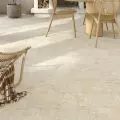A storm has started over the modernist Jowita dormitory in downtown Poznań. The university wants to sell it, there is talk of demolition. Students and an MP are protesting. However, the discussion with the university authorities is chaotic. Hardly surprising: the academics and the city have not prepared the substantive ground for the debate. Only now are they talking about the competition.
The Jowita Student House has stood for half a century (1964) in downtown Poznań, at the Kaponiera traffic circle and Zwierzyniecka Street (period photos: here). The heavily exposed eleven-story building, along with a lower pavilion housing, among other things, a popular canteen, was conceived in the 1960s as one of the elements of the modern „housing” of the then-planned traffic circle (completed in 1973) and the new wide arteries connected to it. In the 1960s, the neighborhood saw the construction of, among others, the 1964 Merkury Hotel and the 1967 ceramic industry skyscraper. Jowita was designed by talented architects of the younger generation, working at Poznan's Miastoprojekt: Witold Milewski and Zygmunt Skupniewicz.
Jowita Student House in Poznan—View from Swiety Marcin Street (under renovation), across the Caponiera traffic circle. From left: Academy of Music, Bałtyk office building, Jowita, Collegium Iuridcum UAM
Photo: Jakub Głaz
retro luxury
In communist Poland, Jowita had the status of a luxury dormitory—for foreigners or domestic lucky students in their final years. It was also famous for its thriving, popular student club and the Accumulators gallery, which took its name from the distinctive advertising neon sign on the roof. In recent decades, however, Jowita has declined, and for several years the media has reported on plans for its closure and sale by Adam Mickiewicz University.
Now the word is about to become flesh. Prof. Bogumiła Kaniewska, rector of the Adam Mickiewicz University, has announced that the university is closing Jowita in June, as well as trying to sell it. The reasons are said to be its poor technical condition, the enormous cost of renovation in line with modern technical conditions and—not exactly presumptuous when it comes to selling—the unregulated status of the land under the building. As a replacement for Jowita, UAM is offering students places in new dormitories nearing completion at the UAM campus in outlying Morasko.
Jowita Student House in Poznań—The ceramic cladding of the dormitory is made of cullet from the porcelain factory in Chodzież
Photo: Jakub Głaz
students protest
The word "demolition" has not been officially mentioned in the context of the sale, but according to unofficial information repeated for a long time, the potential owner could have such plans. Standing next to Jowita since 2017 are the successful and very distinctive Baltic office building (designed by MVRDV) and the historic Concordia printing plant, as well as the architecturally inferior Sheraton Hotel (2006, designed by MAT). According to some reports, the latter could even be eventually demolished (after the city's COB company completes its contract with the hotel chain).
Sheraton Hotel on Bukowska Street, in the quarter where Jowita stands—Sheraton Hotel on Bukowska Street (Jowita is behind the building)
photo: Jakub Głaz
Then, after the removal of Jowita and the hotel, the possibility of creating a large coherent project in harmony with the Baltic, which now dominates the space, opens up ( there is no local plan for the area, development conditions would decide). Such a vision, by the way, appeared on the sidelines of entries in a student competition for a concept for the redevelopment of the neighboring Fair.
However, UAM students strongly protested against the decision to close and plans to sell. The activists of the Student Housing Initiative are against the liquidation of the well-located student house and another move to move university life out of the center, after many departments were moved to Morasko. They also point to the lack of an equally cheap alternative to renting a room on the open market.
Jowita Student House in Poznań—Entrance to the canteen, one of the signs in defense of Jowita
photo: Jakub Głaz
will there be a competition?
A few days before Easter, during the Student Parliament, the students called on the university authorities to meet and hand over documentation indicating the poor condition of the building. The topic was picked up by KO club MP Franciszek Sterczewski, who furthermore wanted Jowita's building to be "treated as a monument." The meeting between the students and the rector and UAM representatives finally took place on the evening of Thursday, April 13. During a rather heated exchange, university representatives finally declared their willingness to organize an architectural competition regarding Jowita (video report: here).
Before that, however, the students' protest stirred the emotions of cognoscenti contributing to local media forums and social media. Opinions are divided, especially on the issue of architecture. After all, Jowita arouses emotions for three reasons: sentimental, utilitarian and—probably in the last order—architectural and urban planning. First, many residents associate it with the student club and gallery that was cherished decades ago. Second, students stimulate downtown life, and the attractively located dorm sustains it. Third, Jowita is a decent representative of Poznan's late modernism, in addition by respected architects specializing in college architecture.
However, if claims are heard that Jowita is one of Poznań's icons, it is more about the place, its function and history, rather than its appearance. The building, with its apt proportions and serene façade lined with bright ceramic stucco, is rather decent background architecture. Those who criticize it are probably irritated not by the „ugliness” of Jowita, but by the dissonance between its somewhat blocky form and the prominent place where it is located. The interface between the university complex and the old tenement buildings on Zwierzyniecka Street is also unfortunate.
Jowita Student House in Poznan—View from Zwierzyniecka Street. Western elevation, lump of canteen and club, old tenement buildings.
photo: Jakub Głaz
there were to be two towers
The designers themselves actually had more ambitious intentions for Jowita . Originally there were to be two eighteen-story skyscrapers constituting a strong dominant feature emphasizing the traffic circle and the end of Swiety Marcin Street. The authorities truncated these plans. More than 10 years ago, Zygmunt Skupniewicz commented on it in his book "Projekt Miasto" as follows :
Święty Marcin Street demands a view closure on the west side. It could have been the appropriately tall Jowita building. Unfortunately, all such proposals (...) were lost. The principle that in provincial cities one builds up to 11 stories, and higher only in the capital—prevailed. Currently, on stabilized land, there is a possibility of overbuilding Jowita by three or four stories, which would improve the scale of the complex.
However, Jovita was not overbuilt. Instead, the dominant closing feature of St. Martin's is now the 68-meter-high Baltic. Jowita has visually "diminished". At the same time, it is difficult to unequivocally recognize it as a building of outstanding architectural value. Poznan has better modernist buildings, and by 2010 it was even abundant in two works verging on outstandingness: a hall with a tendon roof and a multi-story pavilion on the grounds of the Poznan International Fair (designed 1961). Both, however, unlike Jowita, were hidden behind the fair's fence and did not exist in the public consciousness of the residents, so their demolition was carried out quietly, without witnesses or protests.
Jowita Student House in Poznań—Neglected courtyard with a connector between the student house and the canteen, view from the bus stop on Zwierzyniecka Street
Photo: Jakub Głaz
discussion lesson not done
The discussion about Jovita is chaotic so far, and shows how laboriously progress is going in thoughtful decision-making about urban space, architecture and heritage. This is evidenced by the arbitrarily communicated decision of UAM (a university that has a department dedicated to spatial planning!), nervous reactions from students, emotional statements on discussion forums, or the call for Jowita to be declared a monument. The latter demand seems strongly over the top. On the other hand, the demolition of Jowita must not be allowed before any alternative (competition) concepts are developed. It is also worth considering guaranteeing the existence of a dormitory function in a possible new building.
Jowita Student House in Poznań—View of Jowita and Zwierzyniecka Street from the walkway between the former printing house (pictured) and the Bałtyk office building
photo: Jakub Glaz
Moreover, in a decent city the whole situation would look different. It would be the city's architect who would start a debate about the controversial site and the public owner's intentions, together with him ordering from the City Urban Planning Studio some sketchy try-outs for a different way of development and a handy mock-up of the area. Then—among professionals and residents—he would consider the next steps. Before the debate, everyone could read the history of the building and the site on the city's website, read arguments defending the status quo and opting for change. With this and efficient moderation, the debate could be more substantive, dynamic and informative. The result: tensions drop, trust grows, concrete arguments—social, urban, historical and aesthetic—come to the fore.
In the meantime, as in the case of other Polish attempts to sell or demolish significant or well-known buildings, the discussion is taking place at the last minute, under pressure and with little transparency. This is further evidence of the lack of vision and decent coordination of the spatial development of Poznan.




















































